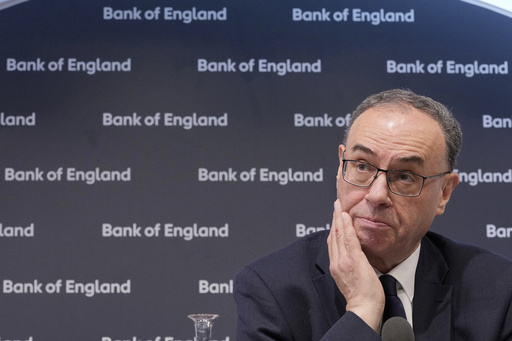LONDON — The Bank of England has scaled down its growth forecast for the British economy this year, reducing it by half while lowering its main interest rate for the third time in six months.
In a recent announcement, the central bank’s Monetary Policy Committee, comprised of nine members, decided to decrease the interest rate by a quarter point to 4.50%, marking its lowest level since the middle of 2023.
This change was largely anticipated by market participants.
However, the corresponding economic projections unveiled a more significant reduction than many had expected, with the Bank now anticipating that the British economy will expand by only 0.75% this year—down from the earlier estimate of 1.5% made just three months prior.
If this prediction holds true, it could be quite disappointing for the newly elected Labour government, which has prioritized economic growth as a key agenda in order to enhance living standards and secure funding for essential public services. The party’s approval ratings have declined sharply since its July election victory, as tangible growth appears increasingly elusive.
Treasury chief Rachel Reeves, who previously faced backlash for her October budget’s tax hikes on businesses, expressed her approval of the interest rate reduction but noted that she remains “not satisfied with the growth rate.” She emphasized that the government intends to “move faster to stimulate economic growth.”
The government likely hopes that further cuts to interest rates in the upcoming months will assist in its economic objectives by lowering mortgage rates and making loans more affordable, although this would also reduce returns for savers.
However, the financial markets remain uncertain regarding the potential for additional rate reductions this year, particularly as the Bank is forecasting inflation to exceed expectations in the near term. The anticipated inflation rate is projected to reach 3.7% in the first half of the year before slowly returning to the target rate of 2%.
In light of this environment of fluctuating growth and inflation, Bank Governor Andrew Bailey remarked on the uncertain outlook facing the British economy, which could become even more unpredictable should U.S. President Donald Trump follow through on threats of new tariffs.
“We will closely observe both the U.K. economy and developments on a global scale, adopting a careful and gradual approach when it comes to further rate reductions,” Bailey asserted. He underscored the importance of maintaining low and steady inflation as a cornerstone of a robust economy, reaffirming the Bank of England’s commitment to that goal.
A noteworthy aspect of Thursday’s decision was that two members of the decision-making panel voted for an even greater reduction of half a percentage point, bringing rates down to 4.25%.
Luke Bartholomew, deputy chief economist at abrdn, pointed out that this dissenting vote indicates some policymakers’ significant concern regarding the obstacles to economic growth.
While the rate-setting committee does not explicitly target growth as part of its mandate—its primary goal is to steer inflation, as determined by the consumer prices index, towards the 2% target over the next few years—slower growth typically correlates with moderated inflation, indicating reduced demand within the economy.
Although the current inflation rate stands at 2.5% and is expected to rise in the coming months—partly due to new business tax increases implemented by the Labour government—most economists anticipate a decline towards the target rate thereafter, which enabled the panel to proceed with the rate cut on Thursday.
Inflation has significantly decreased from the highs experienced in recent years, a trend influenced by central banks raising borrowing costs from near-zero levels during the pandemic. This rise in prices was first spurred by supply chain issues, later compounded by the energy price hikes resulting from Russia’s invasion of Ukraine.
As inflation rates have eased from historical peaks, central banks globally, including the U.S. Federal Reserve, have begun to lower interest rates; however, few economists foresee rates declining to the exceptionally low levels that prevailed following the 2008-2009 financial crisis and during the pandemic period.
Copyright @2024 | USLive | Terms of Service | Privacy Policy | CA Notice of Collection | [privacy-do-not-sell-link]



